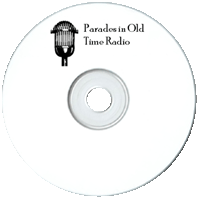

Relive the nostalgia of parades yesteryear - both real and fictional. These are great celebrations!

24 old time radio show recordings
(total playtime 10 hours, 51 min)
available in the following formats:
1 MP3 CD
or
11 Audio CDs
Text on OTRCAT.com ©2001-2025 OTRCAT INC All Rights Reserved. Reproduction is prohibited.


One of the most popular parade features is parade floats. These fanciful creations got their name because they were highly decorated barges towed along canals by marchers. Some canal floats were propelled by oarsmen hidden within the structure of the float, but the flimsy construction of the float barges led to several drownings. Some of the earliest "grounded floats" were horse-drawn affairs used in ceremonies honoring the drowned oarsmen. In modern practice, floats are usually towed by motor vehicles or self-propelled with the driver in a hidden compartment. On The Alan Young Show, our hero is entrusted with the secret plans for the Van Nuys Rose Parade float, which is not certain to end well.
The tradition of parades as civic celebrations has its origins in military marching drill. Drilling troops arose as armies began fighting as units rather than individuals. Tactically, formation fighting reached its apex during the Napoleonic Era but using such tightly grouped forces became suicidal with the development of breech loading rifles, artillery, and especially machine guns. Close-order formation marching is still an important part of military training because of the teamwork and discipline it instills, even though its use is largely ceremonial. A ceremonial military parade is the centerpiece of the fourteenth episode of Jerry At Fair Oaks.

After the Memorial Day Parade, our favorite water commissioner decides that it is time for him to draft a will, and he considers endowing the city with a statue of The Great Gildersleeve. Wistful Vista's leading citizens, Fibber McGee and Molly are called upon to lead the town parade, on horseback! This unlikely feat is more than matched by Charlie McCarthy's intention to lead the parade opening the New York World's Fair from the back of an elephant. Upset horses interfere with the parade opening the newest amusement park in Metropolis, Happyland, but the Man of Steel has reason to suspect foul play on The Adventures of Superman.
A parade becomes an unlikely public relations tool when a genuine Martian hires a PR firm to publicize that the Martians are coming in "The Parade" on Dimension X and X Minus One. The Columbia Workshop presents some rather fanciful parades, including an imaginary one down a New York street in "And to Think I Saw It on Mulberry Street", and a heavily allegorical anti-war story from the streets of New York where "The Parade" can neither be seen or heard. Perhaps the most imaginative parade in radio was the Christmas Parade on the 24th (of 26) episode of The Cinnamon Bear.
Text on OTRCAT.com ©2001-2025 OTRCAT INC All Rights Reserved. Reproduction is prohibited.
You have reached the maximum number of votes for a unregistered user.
Please login or create a new account to continue...
You have reached the maximum number to down votes in this page.



Parades Disc A001
|
Add Audio CD to Cart - $5.00 |
Parades Disc A002
|
Add Audio CD to Cart - $5.00 |
Parades Disc A003
|
Add Audio CD to Cart - $5.00 |
Parades Disc A004
|
Add Audio CD to Cart - $5.00 |
Parades Disc A005
|
Add Audio CD to Cart - $5.00 |
Parades Disc A006
|
Add Audio CD to Cart - $5.00 |
Parades Disc A007
|
Add Audio CD to Cart - $5.00 |
Parades Disc A008
|
Add Audio CD to Cart - $5.00 |
Parades Disc A009
|
Add Audio CD to Cart - $5.00 |
Parades Disc A010
|
Add Audio CD to Cart - $5.00 |
Parades Disc A011
|
Add Audio CD to Cart - $5.00 |
Please wait...
COMMENTS
Robert Verified Purchase
Jolly
Leave a comment